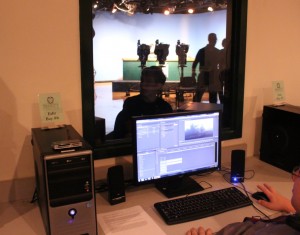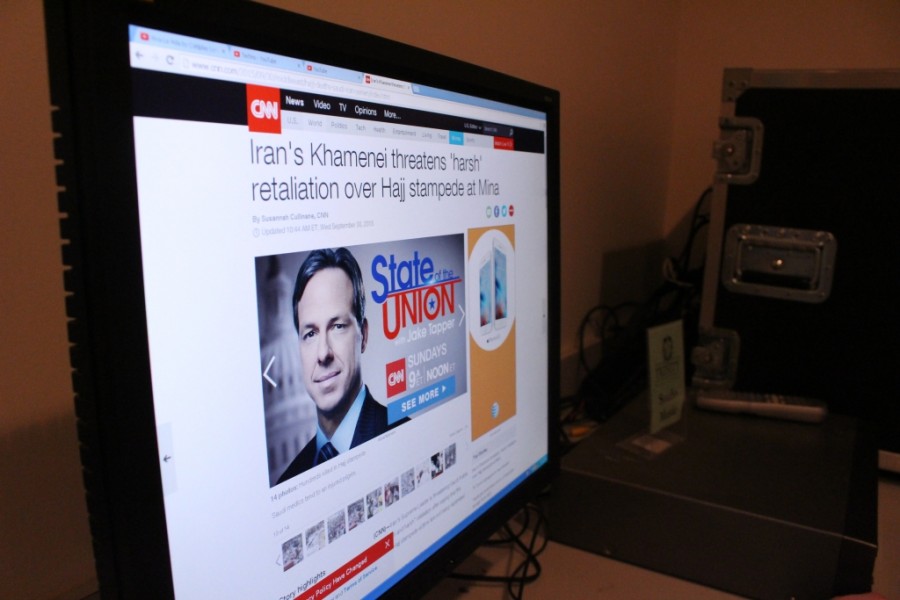New Professional Affiliate TTV Adds Three Big Letters to Its Resume
Trinity is one of only two high schools in Kentucky that can claim affiliate status with CNN.
October 26, 2015
It’s one of the first channels people turn to for breaking news. It was the first 24-hour news station. As of February 2015, it’s available to approximately 92 million cable, satellite and telco television households in the United States. It’s the Cable News Network, commonly known as CNN. Trinity Television recently joined the CNN family as a “Newsource in the Classroom” affiliate.
This connection means that TTV, with help from CNN, reports on real-world news. Trinity and St. Xavier are the only two high schools in Kentucky that have this affiliation with CNN — only 59 high schools nationally.
Senior Nathan Schmitt, a reporter and anchor for TTV, described the biggest difference between the format for TTV last school year and this school year.

Trinity’s daily TTV production includes news from CNN.
“This year we are pairing with CNN and reporting actual news, not just what’s going on in the school. So, we can report world news and anything CNN has reported,” Schmitt said.
The head of Trinity’s student news program, Mr. Adam Klein, explained how Trinity initially became a CNN affiliate.
Klein said, “Last spring, I attended the Kentucky High School Journalism Association convention, and while we were there, there was a presentation put on by the University of Kentucky’s broadcast journalism program. They were talking about some of the different things they include in their program that are timely and give students some hands-on experience with editing footage. This gives them an opportunity to stay in touch with what’s going on in the news now.”
This affiliation is good for the Trinity student body, Klein said.
“This would be a great way for our guys to be able to include some news that’s going on,” Klein said. “A lot of times news for our students is ‘outside the bubble’– it’s not in their realm or they don’t know anything about it. I wanted to incorporate that for the student population. ”
The TTV staff benefits as well, according to Klein.
He said, “I wanted them to be able to do something that was kind of new and fresh. Much of our time in TTV is spent creating a daily news show that is, let’s face it, filled with just announcements from teachers and administrators and coaches — not a whole lot of broadcast journalism going on.
“Now our guys produce news stories for things like ‘The Rock,’ but I wanted to give them a little bit more exposure to it, more contact with it.”
Klein described how the TTV staff really has very little time to pump out the CNN stories.
He said, “They come in every day, and they’re given the footage and they’re given the summary of the story. They have to put together a news story in a very short period of time. They have to coordinate that with the anchors and get it all edited, get it produced and get it to me by the end of the period.”
The new format, Klein said, is better preparing his students for journalism in the real world.
“It’s a great expectation for them to be able to do (the affiliate work), but they’ve been able to rise to the occasion and been able to do that with very little problem. And I think that’s what they’re going to run into in the real world. If they were to become a news producer, their job is to create a lineup every day of stories.”
TTV pulls stories straight from CNN’s online database. Klein said, “We have all the same stories that you see on CNN, all the footage, all the sound bites.”
TTV’s affiliation with CNN is just another step in the growth process that TTV is continually undergoing.
“I think it says that our program is growing,” Klein said. “We’re improving. I think we’ve always had a strong broadcast program. I think within the last six or seven years since I’ve taken over the program, I’ve tried to tinker with it, I’ve tried to improve upon it, whether it be adding ‘The Rock’ or with CNN.
“(We’re) trying to get away from the same everyday repetition. Compared to a lot of schools, we are on the cutting edge as far as the technology we’re using, and I think it says that our guys are producing some quality work.
“Students that graduate from this program can go on, and they’re going to be successful, whether they go to a small program like UK, or a medium-sized program like Western Kentucky — or even if they were to go on to Missouri or some of the other journalism programs in the United States. I think our guys are going in, and they have a good basis, a good foundation to be successful in a college broadcast journalism program.”
Klein believes CNN appreciates the work TTV is producing. “I think CNN recognizes that we’re not just stumbling around in the dark,” he said, “that we know what we’re doing. They trust us with their footage, and they want us to be able to use it as a teaching tool.”
Schmitt, from a reporter’s standpoint, thinks the change to TTV is for the better. “It gives us a view on the world. You can see what else is going on. For some people, it’s the only news we get,” he said. “This may interest some people; others it might not make any difference.”
Just as with any population, something new draws different reactions. Senior Jack Allen said the CNN news takes up “way too much time. I don’t pay attention to it. I watch the news at home, so I see it twice and it kind of annoys me. I liked the regular TTV.”
Senior Quinn Zoeller, however, said the new TTV format is informative and helpful to the student body.
“I think it’s important for kids who may not pay attention to the news. It’s always important to know what’s going on outside of Trinity, so it can be a really good thing to just have a quick rundown of the top news stories right before you go to regular TTV,” Zoeller said.
Zoeller said he likes the new TTV format. “I like that it’s quick and that it’s just pretty much a real quick rundown, and that it’s not like a lot of the extra stuff that a lot of big news outlets put on news stories. It tells you what you need to know, and it gives you a bunch of big news stories instead of fleshing out just one big one.”
Check out some of TTV’s behind-the-scenes broadcast work. Video by Connor Rafferty and Jacob Travelstead.


